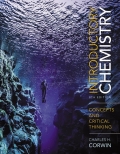
EBK INTRODUCTORY CHEMISTRY
8th Edition
ISBN: 9780134553153
Author: CORWIN
Publisher: PEARSON CO
expand_more
expand_more
format_list_bulleted
Concept explainers
Question
Chapter PSS, Problem 44E
Interpretation Introduction
Interpretation:
The mass of a helium atom given as
Concept introduction:
The ordinary numbers are written as the power of
In scientific notation, the non-zero significant numbers are written along with the power of
Expert Solution & Answer
Want to see the full answer?
Check out a sample textbook solution
Students have asked these similar questions
Look at the image att
Please see the attached image bel
Look at the image att
Chapter PSS Solutions
EBK INTRODUCTORY CHEMISTRY
Ch. PSS - Prob. PSS.1CECh. PSS - Prob. PSS.2CECh. PSS - Prob. PSS.3CECh. PSS - Prob. PSS.4CECh. PSS - Prob. PSS.5CECh. PSS - Prob. PSS.6CECh. PSS - Prob. PSS.7CECh. PSS - Prob. PSS.8CECh. PSS - Prob. PSS.9CECh. PSS - Prob. PSS.10CE
Ch. PSS - Prob. 1KTCh. PSS - Prob. 2KTCh. PSS - Prob. 3KTCh. PSS - Prob. 4KTCh. PSS - Prob. 5KTCh. PSS - Prob. 6KTCh. PSS - Prob. 7KTCh. PSS - Prob. 8KTCh. PSS - Prob. 9KTCh. PSS - Prob. 10KTCh. PSS - Prob. 11KTCh. PSS - Prob. 12KTCh. PSS - Prob. 13KTCh. PSS - Prob. 1ECh. PSS - Prob. 2ECh. PSS - Prob. 3ECh. PSS - Prob. 4ECh. PSS - Prob. 5ECh. PSS - Prob. 6ECh. PSS - Prob. 7ECh. PSS - Prob. 8ECh. PSS - Prob. 9ECh. PSS - Prob. 10ECh. PSS - Prob. 11ECh. PSS - Prob. 12ECh. PSS - Prob. 13ECh. PSS - Prob. 14ECh. PSS - Prob. 15ECh. PSS - Prob. 16ECh. PSS - Prob. 17ECh. PSS - Prob. 18ECh. PSS - Prob. 19ECh. PSS - Prob. 20ECh. PSS - Prob. 21ECh. PSS - Prob. 22ECh. PSS - Prob. 23ECh. PSS - Prob. 24ECh. PSS - Prob. 25ECh. PSS - Prob. 26ECh. PSS - Prob. 27ECh. PSS - Prob. 28ECh. PSS - Prob. 29ECh. PSS - Prob. 30ECh. PSS - Prob. 31ECh. PSS - Prob. 32ECh. PSS - Prob. 33ECh. PSS - Prob. 34ECh. PSS - Prob. 35ECh. PSS - Prob. 36ECh. PSS - Prob. 37ECh. PSS - Prob. 38ECh. PSS - Prob. 39ECh. PSS - Prob. 40ECh. PSS - Prob. 41ECh. PSS - Prob. 42ECh. PSS - Prob. 43ECh. PSS - Prob. 44ECh. PSS - Prob. 45ECh. PSS - Prob. 46ECh. PSS - Prob. 47ECh. PSS - Prob. 48ECh. PSS - Prob. 49ECh. PSS - Prob. 50ECh. PSS - Prob. 51ECh. PSS - Prob. 52ECh. PSS - Prob. 53ECh. PSS - Prob. 54ECh. PSS - Prob. 55ECh. PSS - Prob. 56ECh. PSS - Prob. 1STCh. PSS - Prob. 2STCh. PSS - Prob. 3STCh. PSS - Prob. 4STCh. PSS - Prob. 5STCh. PSS - Prob. 6STCh. PSS - Prob. 7STCh. PSS - Prob. 8STCh. PSS - Prob. 9STCh. PSS - Prob. 10ST
Knowledge Booster
Learn more about
Need a deep-dive on the concept behind this application? Look no further. Learn more about this topic, chemistry and related others by exploring similar questions and additional content below.Similar questions
- V Biological Macromolecules Drawing the Haworth projection of an aldose from its Fischer projection Draw a Haworth projection of a common cyclic form of this monosaccharide: H C=O HO H HO H H OH CH₂OH Explanation Check Click and drag to start drawing a structure. Xarrow_forwardComplete the mechanismarrow_forwardComplete the mechanismarrow_forward
- 8 00 6 = 10 10 Decide whether each of the molecules in the table below is stable, in the exact form in which it is drawn, at pH = 11. If you decide at least one molecule is not stable, then redraw one of the unstable molecules in its stable form below the table. (If more than unstable, you can pick any of them to redraw.) Check OH stable HO stable Ounstable unstable O OH stable unstable OH 80 F6 F5 stable Ounstable X Save For Later Sub 2025 McGraw Hill LLC. All Rights Reserved. Terms of Use | Privacy C ཀྭ་ A F7 매 F8 F9 4 F10arrow_forwardJust try completing it and it should be straightforward according to the professor and TAs.arrow_forwardThe grading is not on correctness, so if you can just get to the correct answers without perfectionism that would be great. They care about the steps and reasoning and that you did something. I asked for an extension, but was denied the extension.arrow_forward
- Show your work and do something that is reasonable. It does not have to be 100% correct. Just show something that looks good or pretty good as acceptable answers. Something that looks reasonable or correct would be sufficient. If you can get many of them correct that would be great!arrow_forwardShow your work and do something that is reasonable. It does not have to be 100% correct. Just show something that looks good or pretty good as acceptable answers. Something that looks reasonable or correct would be sufficient. If you can get many of them correct that would be great!arrow_forwardTake a look at the following molecule, and then answer the questions in the table below it. (You can click the other tab to see the molecule without the colored regions.) with colored region plain 0= CH2-0-C-(CH2)16-CH3 =0 CH-O-C (CH2)7-CH=CH-(CH2)5-CH3 D CH3 | + OMPLO CH3-N-CH2-CH2-0-P-O-CH2 B CH3 A Try again * 000 Ar 8 0 ?arrow_forward
arrow_back_ios
SEE MORE QUESTIONS
arrow_forward_ios
Recommended textbooks for you
 Chemistry: The Molecular ScienceChemistryISBN:9781285199047Author:John W. Moore, Conrad L. StanitskiPublisher:Cengage Learning
Chemistry: The Molecular ScienceChemistryISBN:9781285199047Author:John W. Moore, Conrad L. StanitskiPublisher:Cengage Learning

Chemistry: The Molecular Science
Chemistry
ISBN:9781285199047
Author:John W. Moore, Conrad L. Stanitski
Publisher:Cengage Learning
The Creation of Chemistry - The Fundamental Laws: Crash Course Chemistry #3; Author: Crash Course;https://www.youtube.com/watch?v=QiiyvzZBKT8;License: Standard YouTube License, CC-BY